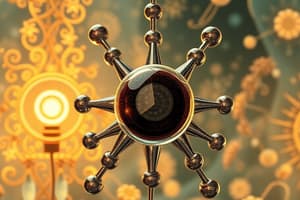Podcast
Questions and Answers
John Dalton is considered the father of modern chemical bonding.
John Dalton is considered the father of modern chemical bonding.
False (B)
J.J. Thomson discovered the neutron using cathode rays.
J.J. Thomson discovered the neutron using cathode rays.
False (B)
The mole concept is a fundamental concept in stoichiometry.
The mole concept is a fundamental concept in stoichiometry.
True (A)
Atomic theory has remained unchanged since ancient times.
Atomic theory has remained unchanged since ancient times.
All atoms of a given element have different masses and properties.
All atoms of a given element have different masses and properties.
Chemical reactions involve the creation of new atoms.
Chemical reactions involve the creation of new atoms.
The atomic number of an element is the sum of its protons and neutrons.
The atomic number of an element is the sum of its protons and neutrons.
Isotopes of the same element have different chemical properties due to the difference in neutrons.
Isotopes of the same element have different chemical properties due to the difference in neutrons.
The first electron shell can hold a maximum of 4 electrons.
The first electron shell can hold a maximum of 4 electrons.
Valence electrons are the electrons in filled shells that participate in chemical bonding.
Valence electrons are the electrons in filled shells that participate in chemical bonding.
The mass number of an element is the sum of its protons and electrons.
The mass number of an element is the sum of its protons and electrons.
Atoms form bonds to achieve a stable electronic configuration.
Atoms form bonds to achieve a stable electronic configuration.
The reactant that produces more moles of the product is the limiting reactant.
The reactant that produces more moles of the product is the limiting reactant.
The actual yield is always equal to the theoretical yield in a chemical reaction.
The actual yield is always equal to the theoretical yield in a chemical reaction.
The percentage yield is calculated by dividing the theoretical yield by the actual yield.
The percentage yield is calculated by dividing the theoretical yield by the actual yield.
The limiting reactant is always the reactant with the largest amount of moles.
The limiting reactant is always the reactant with the largest amount of moles.
The mole ratio of the reactants is used to calculate the limiting reactant.
The mole ratio of the reactants is used to calculate the limiting reactant.
The theoretical yield can be calculated using the amount of any reactant.
The theoretical yield can be calculated using the amount of any reactant.
In a balanced equation, the coefficients indicate the mass-to-mass ratios of reactants and products.
In a balanced equation, the coefficients indicate the mass-to-mass ratios of reactants and products.
1 mole of a substance is equal to Avogadro’s number of particles.
1 mole of a substance is equal to Avogadro’s number of particles.
The mole relationship can be used to convert between the number of particles and the volume of a substance.
The mole relationship can be used to convert between the number of particles and the volume of a substance.
The balanced equation for the reaction between potassium and water is 2K + 2H₂O → 2KOH + H₂.
The balanced equation for the reaction between potassium and water is 2K + 2H₂O → 2KOH + H₂.
In the equation N₂ + 3H₂ → 2NH₃, 1 mole of nitrogen gas reacts with 2 moles of hydrogen gas.
In the equation N₂ + 3H₂ → 2NH₃, 1 mole of nitrogen gas reacts with 2 moles of hydrogen gas.
0.120 mol Na is equal to 7.22 × 10^23 atoms of Na.
0.120 mol Na is equal to 7.22 × 10^23 atoms of Na.
The limiting reagent is always the substance in the lesser amount.
The limiting reagent is always the substance in the lesser amount.
The mole ratio from the balanced equation is used to calculate the expected moles of the product for each reactant.
The mole ratio from the balanced equation is used to calculate the expected moles of the product for each reactant.
The percentage yield can be calculated by comparing the actual yield to the theoretical yield.
The percentage yield can be calculated by comparing the actual yield to the theoretical yield.
The reactant that produces the least amount of product is the limiting reagent.
The reactant that produces the least amount of product is the limiting reagent.
The actual yield is always greater than the theoretical yield.
The actual yield is always greater than the theoretical yield.
The mass of the limiting reactant determines the theoretical yield.
The mass of the limiting reactant determines the theoretical yield.
Flashcards are hidden until you start studying



